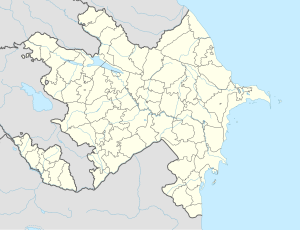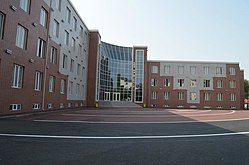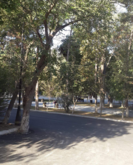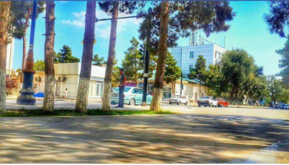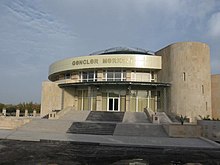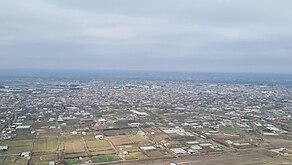Sabirabad (city)
This article may need to be rewritten to comply with Wikipedia's quality standards. (June 2020) |
Sabirabad | |
|---|---|
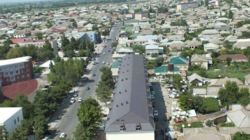 | |
Location in Azerbaijan | |
| Coordinates: 40°00′46″N 48°28′44″E / 40.01278°N 48.47889°E | |
| Country | |
| District | Sabirabad |
| Established date | 1888 |
| Government | |
| • City executive representative | Ahadagha Aliyev[2] |
| Area | |
| • Total | 1,246 km2 (481 sq mi) |
| Elevation | −12 m (−39 ft) |
| Population (2018) | |
| • Total | 30,612[1] |
| • Density | 2,460/km2 (6,400/sq mi) |
| • Population Rank in Azerbaijan | 21st |
| Time zone | UTC+4 (AZT) |
| Area code | +994 21 |
| Vehicle registration | 54 AZ |
| Website | sabirabad-ih.gov.az |
Sabirabad (also, Galagayin, Petropavlovka, and Petropavlovskoye) is the capital city of the Sabirabad District of Azerbaijan. The city was renamed in honor of the poet Mirza Alakbar Sabir.[3] Sabirabad is the administrative center of Sabirabad District of the Republic of Azerbaijan. In 1935, the district received the status of subordinate city. Sabirabad is located on the right bank of the Kura River. In the vicinity of the city of Sugovushan, the Araz River is merged with the Kur River.
History
[edit]According to Gulistan Peace Treaty of 12 October 1813, a part of the khanates of Azerbaijan was occupied by the Russians, as well as the territory of Mughan. As a result of the administrative territorial reforms carried out in Russia, a new territory—Javad Uyezd—was established in 1868. Later, a large group of Ukrainian peasants was settled in Javad, and the settlement was referred to as Petropavlovka after 1888.

Petropavlovka was part of the Javad area (gaza) of the Baku Governorate. In 1901, there were only 87 farms in the area, and in 1907 the number of Russian villages in those areas was 13. In 1913, there was a cotton-cleaning plant, and two industrial enterprises-mills were put into operation. On May 1, 1920, Petropavlovsk became the local state power body of the Revolutionary Committee of the Djevatskoye Uyezd, after Azerbaijan once again came under Russian control following the Soviet offensive that absorbed the Azerbaijan Democratic Republic. From May 1, 1921, to April 8, 1929, Sabirabad region operated as the Petropavlovsk district of Djevatskoye Uyezd . On April 8, 1929, by the decision of the VI All-Azerbaijani Soviet Congress, it was called the Petropavlovsk district of Mugan district. On August 8, 1930, according to the Central Executive Committee's decision # 476, the district system was abolished and Petropavlovsk became an independent region. Almost a year later, on October 7, 1931, by the Decree of the Central Executive Committee of Azerbaijan, Petropavlovsk was renamed after Azerbaijani poet Mirza Alakbar Sabir, considered the founder of public satire in Azerbaijani classical literature.[4]
Creation of Sabirabad city
[edit]Ancient Javad was one of the main points on the trade route between Europe and the East. A number of European and Russian travelers and diplomats traveled to Javad, including British Anthony Jenkinson (October 6, 1561), Russians Artemy Sukhanov (1551-1552) and Fyodor Kotov (August 1623), German Adam Olearius (March 31, 1637), Dutchman Jan Jansen Struys (1671-1672), Scottish John Bell, (7 December 1716), and went to Iran, crossing over a bridge over the ships bound by chains.
Some of them wrote here that the town was reminiscent of the city, they have seen many brilliant artisans who produced bricks, cane houses, mud-watered houses, gardens, carpets and various silk fabrics, and even saw weavers. Anthony Jenkinson's remarks, which were in Javad in the Safavid rule, are very interesting. He writes in his October 6, 1562, that "The king's yard has a beautiful palace filled with all kinds of fruits." On his return from Iran in 1563, in Javad on April 6, he met with Abdulla Khan Ustajli, the Shirvan governor in his palace. She also receives a certificate from a gentleman, which permits free trade. In his memoirs A.Jenkinson, reported that the mausoleum was written in his palace in Javad, and was confirmed by the seal of the 12th year of his reign and called himself the "king of Shirvan and Girgan". Javad was a large settlement in the 17th and 18th centuries. Travelers Evliya Çelebi, İ.Lerx, I.Garberq, along with other Shirvan's sights, also saw Javad's "fabric and manufactures" combined with great feudal weavers who produced silk fabrics, carpets and other things, and wrote their own thoughts.
Javad has been an important point in the midst of the 19th centuries, on the sea and the dry trade routes used by the Europeans. Another line of the line called Astrakhan-Rasht road was "Shamakhi-Javad" and "Javad-Lankaran". The Javad's road also became very popular among the people.
Graf Valerian Zubov was camped near Javad on November 21, 1795, when he came to Azerbaijan with the tsarist forces. In this area where the two rivers met, they wanted to set up a city named Yekaterinoserd, to deploy two thousand soldiers there, to marry them with Armenian and Georgian daughters, to provide them with land and agricultural tools.[5] The ships coming from Astrakhan had to vacate their cargo here. They wanted to use this city as a contact point in Georgia, Ganja, Baku, Salyan, Shamakhi and trade with Iran. On March 8, 1736, Nadir Shah was convened here in the place called "Sugovushan", in Galagain, with 100,000 attendees and 20,000 delegates from them. Along with the convention, the agreement, which was discussed with the Ottoman ambassador, was approved at the congress.[6][7] [8][9] The name of Javad was given to a major uyezd. It has been a crucial point for a long time on the Kura ship. From the middle of the 19th century the "Baku-Salyan" and "Salyan-Astara" postings were opened. Meanwhile, Javad began to lose its previous significance slowly. But it remained a fishing point for a long time.
Sabirabad
[edit]The history of Sabirabad city begins in 1868. There was a traditional weekly market (Thursday) in the area between the ancient Sugovushan and Galagain villages on Kur and Araz. The first two-storey building and orthodox church is built from the bricks to create a long-awaited city of Javad this year.

But later, the idea of rebuilding the city was abandoned. In 1887, when Ukrainian villagers were transferred to Mughan, 26 families were settled in this settlement and the village was called Petropavlovsk. There were 87 farms here in 1901. At the end of the 19th century, the village of Petropavlovka was built in the territory of the present city. In 1887, the Ukrainians began to move here.

The village began to develop in the early 20th century. On August 8, 1930, Petropavlovsk became the center of the district. On October 2, 1931, Sabirabad was renamed. In 1952, the settlement took its status as a city on December 4, 1959.


After the second half of the 19th century, the Tsar of Russia sent noble two brothers, Peter and Paul to give them instructions to cultivate cotton here. They lay the basis of a shipyard and shipyard in the present-day Sabirabad city, at the intersection of the cotton plant and the current Heydar Hamidov street and Vidadi street, behind the secondary school named after S. Vurgun on near the junction of Kura Araz, near Javad, Galagain and Kurkandi villages. At that time, the Araz River was in the vicinity of the Kura River. When Pyotr and Pavel produced cotton at the factory, they were going to take the Kura river to the Caspian Sea and then to the Volga River and Russian cities through the ships. Cotton should be harvested in nearby villages. In this way, by giving cotton seeds and other means to nearby villages, they were encouraged to plant cotton and to sign a contract for the purchase of the product.

Many professionals and other workers from Russia are brought here with their families to work at the plant and shipyard. Homes, including hospitals, clubs, and other public buildings are also being built in the area of the plant and port for their survival. Thus, in the territory of present Sabirabad one Russian village is formed. Despite the distortion of the facts, the logic of the Russian empire's policy is so appropriate. After the Turkmenchay treaty of 1828, the Russian Empire completed its occupation policy in the South Caucasus. The southern borders of the empire were known after agreeing with the Iranian kingdom.However, because of the lack of confidence in the protection of these borders, it was entrusted to the people who were deported from Russia and Ukraine. From the Nakhchivan to Astara, Russian villages were built along the entire border. In the territory of Sabirabad, Krasnoselsk (Kara Nuru), Pokrovka (Garatapa), Novodon (Navadan), Aleksandrovka (Shahriyar), Vladimirovka (Nizamikend), Khersonovka (Nasimikend) and other villages were built. The present Sabir canal was also drawn to the Araz River in order to grow crops and meet other water requirements in these villages. Newly populated Russian villages were also located around this canal. In order to undermine the idea of the local community, it was alleged that those who were moved here were expelled from their homeland. In fact, the climate of this place was favorable for their homeland to live. In Siberia, Tyga, and other places in Russia for the exile, it is inexhaustible. It was part of the osvivatization (to own) policy. The local population began to move here from neighboring villages and districts. After the earthquake in Shamakhi in the early twentieth century, a flow of Shamakhi people began and they constructed "Shamakhililar" neighborhood, cemetery and mosque here.

After the revolutionary movements in Iran were deposited, the Iranians immigrated here and settled here in the "hamshary" neighborhood.From western Azerbaijan, those who were deported by Stalin's orders were brought here.Meskhetian Turks also sheltered here.Thus, the population of Sabirabad was formed. After the Tsar empire was replaced by the Soviet Empire, Lenin's attitude towards Azerbaijan was different from that of the previous Tsar. It is said that, after Lenin's coming to power, he did not recognize all the Tsar's treaties apart from the Turkmenchay Treaty. Even Stalin remained loyal to this treaty, and in 1945 Soviet troops were in Tehran, but did not merge Iranian Azerbaijan into the USSR. However, the purpose of the USSR was to capture the lands of neighboring countries in the name of spreading socialism worldwide. South Belarus, Western Ukraine, Bessarabia, Pribaltika were united into the USSR but Iranian Azerbaijan was not merged.
There was also a need for a factory to transform the raw cotton. The Tsar government entrusts this work to the Vagen brothers. They, in turn, invite experts from Germany to build a plant and put into operation in 1906.

Each year, the Kura and Araz rivers flooded the city, causing great damage to the surrounding villages. Thus, the USSR government made a decision to establish a brigade of only two units in the country. Then, as the technique increased, auto stations and tractor repair stations were also created. There were Russian neighborhoods around these offices. These neighborhoods, the surrounding area of the bus station, were called osvoenni.


Geography
[edit]Anthropogenic sediments are spread. The climate is related to the mild-warm semi-desert and dry desert climate. Basically, gray-grass soils are spread. The semi-desert plant prevails in the area. There is also a desert plant in some areas. It is found in saline soils in desert plants. In saline semidescopes often occurs on halophytes: black-brown, cherry orange. They form tuberous hills. Here, also, the Khazar shakhsevdisi, the cabbage rhinoceros, the caterpillar, as well as the one-year rugs - the salty bull and so on. plants are encountered. In the semi-desert group, wormwood, marginal and ephemeral semideserts are widely used in the region. Large areas of the Yovshan semi-arid zone are used under cotton and grain crops.
Population
[edit]By January 1, 2018, the population of Sabirabad is 30,612 people.[citation needed]
Culture
[edit]The architectural monument, known as Old Hamam, is located on Fizuli Street, 27. The building was built in 1901. At present, it is protected as a historical architectural monument and needs major repairs. The monument known as "Shamakhi Mosque" was built in 1903 by residents of Shamakhi who moved to Sabirabad after the earthquake in Shamakhi.




Education
[edit]The total number of secondary schools in the area is 8. There is 1 primary school in the district.[11]
State Social and Economic College
[edit]Sabirabad State Social and Economic College was established through the transformation of Sabirabad Agricultural Technical School, following a decision by the Cabinet of Ministers to enhance the secondary vocational education network. The college employs a staff of 93, including 40 pedagogical workers. Currently, 570 students are enrolled in the following specialties:
- Physical Education
- Vocational Training
- Road Traffic Organization
- Veterinary Science
- Accounting
- Financial Business
- Banking
- Family and Home Education
- Municipal Organization
- Archive Management and Clerical Work
- Library and Information Services
Sabirabad Vocational High School
[edit]Sabirabad Vocational High School was established in 1974 as a secondary vocational school and was granted high school status in 1996. The institution is situated on a 7-hectare campus, featuring one academic building and two dormitories. Currently, 240 students are enrolled at the school.
The school offers training in eight specialties:
- Tractor Operation and Repair
- Agricultural Machinery Repair and Maintenance
- Tractor Reconditioning and Repair
- Animal Artificial Insemination Techniques
- Manual Arc Welding
- Computer Systems Maintenance
- Cotton Cultivation
A staff of 38 educators, comprising 24 teachers and 14 production trainers, is dedicated to the education and professional development of students.
The Vocational High School is equipped with 19 specialized vocational classrooms to support practical training.[12]
Sport
[edit]The Sabirabad District Youth and Sports Department has been operational since 1994. Since its establishment, the department has coordinated all sports organizations in the district. In 2008, the Sabirabad Olympic Sports Complex (OSC) was inaugurated on the initiative of President Ilham Aliyev. The opening of the Sabirabad OSC has significantly contributed to the district's development. Currently, the Sabirabad Olympic Sports Complex offers training in various disciplines, such as Freestyle Wrestling, Boxing, Mini Football, Karate, Strength Training, Table Tennis, Swimming and Athletics.
Football
[edit]The district has made significant strides in developing its football infrastructure and programs. An artificial turf football pitch has been constructed and is currently in use, while construction of a second artificial playing surface has already begun. These developments ensure year-round training and playing capabilities for local athletes.
In terms of team development, the district has established a children's football team for the three-year-old age group, fostering early engagement in the sport. Additionally, the district's Futsal team is competing in the national championship, showcasing the area's sporting ambitions at a competitive level.
These initiatives demonstrate the district's commitment to promoting football across various age groups and skill levels, from early childhood engagement to national-level competition.
Wrestling
[edit]Freestyle wrestling enjoys significant popularity in the district. Currently, approximately 500 adolescents and young people actively participate in this sport. The district has produced several national champions, including Seyfulla Mehdiyev, Vugar Kerimov, and Shahin Abbasov, showcasing the area's talent in wrestling.
The development of wrestling in the district is supported by various local organizations. The Sabirabad Regional Children's Sports School (RCS) and the District Education Department's sports programs are actively involved in nurturing young wrestling talent. These institutions play a crucial role in providing training and opportunities for aspiring wrestlers in the region.
This strong foundation in wrestling not only promotes physical fitness among the youth but also contributes to the district's reputation in national sports competitions.
Boxing
[edit]The Boxing Sport program was established two years ago in the district. Currently, it engages approximately 50 teenagers and young people, demonstrating a growing interest in this combat sport among the local youth.
This newly introduced program has quickly gained traction, attracting a significant number of participants in a relatively short period. The involvement of 50 young athletes suggests that boxing is becoming an increasingly popular athletic pursuit in the area, offering opportunities for physical fitness, discipline, and competitive skill development.
The program's success in attracting and retaining young participants indicates its potential for further growth and its positive impact on the local sports scene. As the program continues to develop, it may contribute to the district's reputation in regional and national boxing competitions, while also promoting healthy lifestyle choices among the youth.
Karate
[edit]Karate athletes from the district have achieved notable success in various competitions. They have participated in national championships, where they have secured victories, demonstrating the high level of skill and training in the local karate program. These accomplishments not only bring recognition to the individual athletes but also highlight the quality of karate instruction and practice in the district.
Athletics
[edit]Athletics enjoys particular popularity in the district's secondary schools, indicating a strong grassroots interest in track and field events. The district has produced notable talent in this field, with Rufat Mehdiyev standing out as a national champion in athletics. His success serves as an inspiration to young athletes in the area and underscores the quality of athletic training available in local schools.
In addition to athletics, table tennis and swimming are also prominent sports in the district. These diverse sporting options provide local residents with a range of opportunities for physical activity and competitive engagement, contributing to the overall health and well-being of the community.[13]
Gallery
[edit]-
Heydar mosque.
-
Park
-
The city school named after great poet Mirza Alakbar Sabir.
-
Sabirabad. The garden on behalf of Sabir.
-
Sabirabad city. Road to traditional market.
-
The garden on behalf of Sabir.
-
Post Office and Communication junction.
-
Sabirabad nights
-
Nighttime
-
Youth Center and Club in Sabirabad city
-
Aerial view of Sabirabad
Notable natives
[edit]- Lutfiyar Imanov — Azerbaijani Soviet singer (dramatic tenor), People's Artist of USSR (1977).[14]
- Elvin Aliyev - football player.
See also
[edit]References
[edit]- ^ "Bələdiyyələr | Azərbaycan Respublikası Sabirabad Rayon İcra Hakimiyyəti". www.sabirabad-ih.gov.az.
- ^ "Sabirabad rayon İcra Hakimiyyəti başçısının aparatında rayon (şəhər) məhkəmələrinin baxdığı inzibati xətalar haqqında işlər üzrə protokol tərtib etmək səlahiyyəti olan vəzifəli şəxslərin siyahısı | Azərbaycan Respublikası Sabirabad Rayon İcra Hakimiyyəti". www.sabirabad-ih.gov.az.
- ^ Gateway Azerbaijan Archived 2004-11-15 at archive.today
- ^ "Tarixi | Azərbaycan Respublikası Sabirabad Rayon İcra Hakimiyyəti". www.sabirabad-ih.gov.az.
- ^ AKAK 1868, p. 246
- ^ Əliyarlı 1996, p. 494
- ^ "Azərbaycan Nadir şah imperiyasının tərkibində (1736-1747)" (PDF) (in Azerbaijani).
- ^ Şahin Fərzəliyev - tarix elmləri doktoru, professor. Quba xanlığı: əhali tarixi və azadlıq mücadiləsi. Bakı, 2012,336 sah.
- ^ "Salman Ərzuman oğlu İbişov.Quba xanlığının əhalisi" (PDF). Archived from the original (PDF) on 2019-01-23. Retrieved 2019-01-23.
- ^ "About this Collection | World Digital Library | Digital Collections | Library of Congress". Library of Congress, Washington, D.C. 20540 USA.
- ^ "Rayon (Şəhər) Təhsil şöbələrinin (İdarələrinin) İnternet İnformasiya Resurslari". regionlist.edu.gov.az.
- ^ "Təhsil | Azərbaycan Respublikası Sabirabad Rayon İcra Hakimiyyəti". www.sabirabad-ih.gov.az.
- ^ "Idman | Azərbaycan Respublikası Sabirabad Rayon İcra Hakimiyyəti". www.sabirabad-ih.gov.az.
- ^ "Иманов Лютфияр Муслим оглы". Great Soviet Encyclopedia.
Sources
[edit]- Əliyarlı, S. (1996), Azərbaycan tarixi [History of Azerbaijan] (in Azerbaijani), Baku: Azərbaycan
- A. P. Berje, ed. (1868), Acts of the Caucasian Archeographic Commission (АКАК), vol. II, 69 document 455, Tiflis: Main Office of the Governor of the Caucasus
External links
[edit]- Sabirabad at GEOnet Names Server
- World Gazetteer: Azerbaijan[dead link] – World-Gazetteer.com
